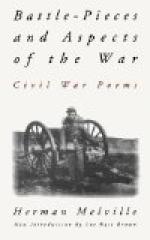18. For a month or two after the completion of peace, some thousands of released captives from the military prisons of the North, natives of all parts of the South, passed through the city of New York, sometimes waiting farther transportation for days, during which interval they wandered penniless about the streets, or lay in their worn and patched gray uniforms under the trees of Battery, near the barracks where they were lodged and fed. They were transported and provided for at the charge of government.
19. Shortly prior to the evacuation of Petersburg, the enemy, with a view to ultimate repossession, interred some of his heavy guns in the same field with his dead, and with every circumstance calculated to deceive. Subsequently the negroes exposed exposed the stratagem.
20. The records of Northern colleges attest what numbers of our noblest youth went from them to the battle-field. Southern members of the same classes arrayed themselves on the side of Secession; while Southern seminaries contributed large quotas. Of all these, what numbers marched who never returned except on the shield.
21. Written prior to the founding of the National Cemetery at Andersonville, where 15,000 of the reinterred captives now sleep, each beneath his personal head-board, inscribed from records found in the prison-hospital. Some hundreds rest apart and without name. A glance at the published pamphlet containing the list of the buried at Andersonville conveys a feeling mournfully impressive. Seventy-four large double-columned page in fine print. Looking through them is like getting lost among the old turbaned head-stones and cypresses in the interminable Black Forest of Scutari, over against Constantinople.
22. In one of Kilpatrick’s earlier cavalry fights near Aldie, a Colonel who, being under arrest, had been temporarily deprived of his sword, nevertheless, unarmed, insisted upon charging at the head of his men, which he did, and the onset proved victorious.
23. Certain of Mosby’s followers, on the charge of being unlicensed foragers or fighters, being hung by order of a Union cavalry commander, the Partisan promptly retaliated in the woods. In turn, this also was retaliated, it is said. To what extent such deplorable proceedings were carried, it is not easy to learn.
South of the Potamac in Virginia, and within a gallop of the Long Bridge at Washington, is the confine of a country, in some places wild, which throughout the war it was unsafe for a Union man to traverse except with an armed escort. This was the chase of Mosby, the scene of many of his exploits or those of his men. In the heart of this region at least one fortified camp was maintained by our cavalry, and from time to time expeditions ended disastrously. Such results were helped by the exceeding cunning of the enemy, born of his wood-craft, and, in some instances, by undue confidence on the part of our men. A body of cavalry, starting from camp with the view of breaking up a nest of rangers, and absent say three days, would return with a number of their own forces killed and wounded (ambushed), without being able to retaliate farther than by foraging on the country, destroying a house or two reported to be haunts of the guerrillas, or capturing non-combatants accused of being secretly active in their behalf.




